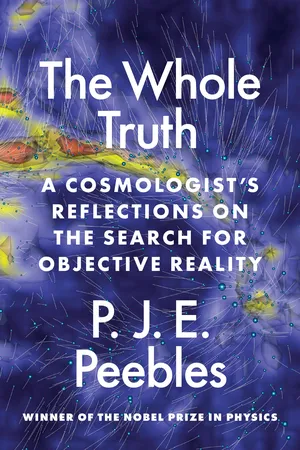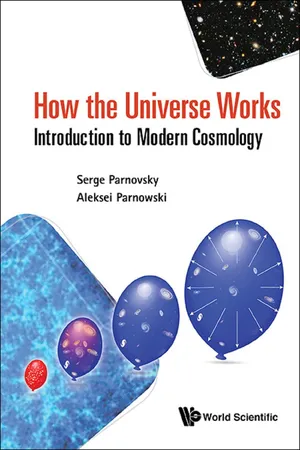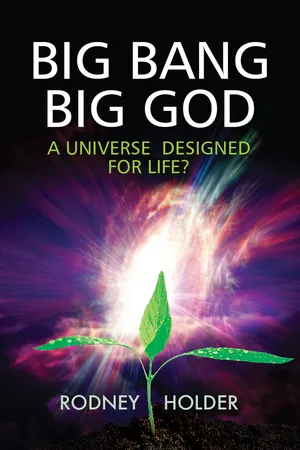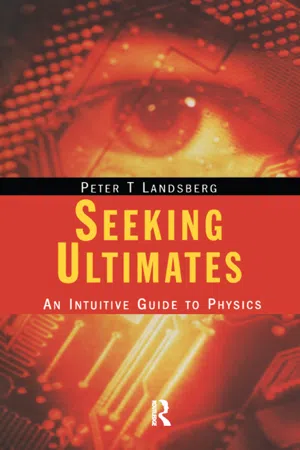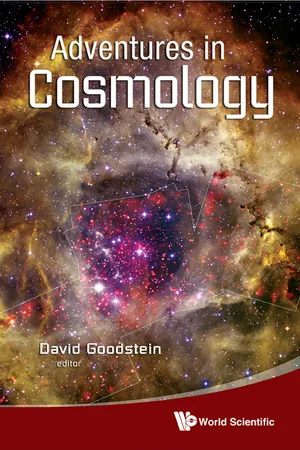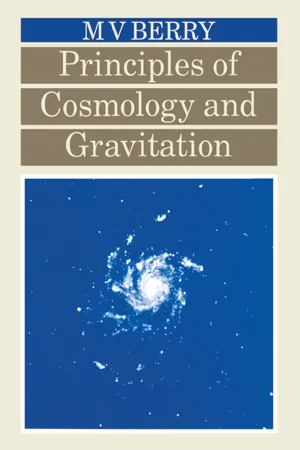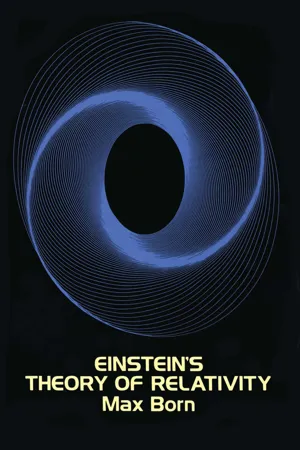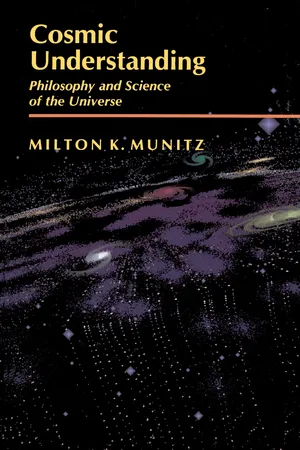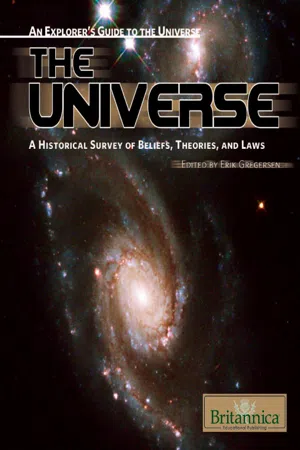Physics
Hubble's Law
Hubble's Law describes the relationship between the distance of galaxies from Earth and their recessional velocity. It states that the farther a galaxy is from us, the faster it appears to be moving away. This law is a key piece of evidence for the expansion of the universe and has significant implications for our understanding of cosmology.
Written by Perlego with AI-assistance
Related key terms
Related key terms
1 of 4
Related key terms
1 of 3
9 Key excerpts on "Hubble's Law"
- eBook - ePub
The Whole Truth
A Cosmologist’s Reflections on the Search for Objective Reality
- P. J. E. Peebles(Author)
- 2022(Publication Date)
- Princeton University Press(Publisher)
Edward Arthur Milne (1933) termed Einstein’s assumption that the universe is the same everywhere the “extended principle of relativity” and “Einstein’s cosmological principle.” The latter became standard. Milne also added theoretical weight to the argument for homogeneity, despite the apparently conflicting astronomical evidence. Milne demonstrated that, if the universe is expanding in a homogeneous and isotropic way, the speed at which a galaxy moves away from us is proportional to its distance. Lemaître (1927) showed that this relation between galaxy distance and its velocity of recession follows from homogeneity in general relativity. Milne proved it from homogeneity for any theory in which distance and relative velocity have the usual meanings. The effect was observed. Hubble and Humason (1931) found that the proportionality predicted by Lemaître and Milne is a good approximation for the most luminous galaxies observed out to distances so great that the recession speed is six percent of the speed of light. This was a considerable advance over Hubble’s (1929) evidence in his first argument for the relation. Hubble and Humason presented an impressively deep probe into the expanding universe.The relation between recession speed and distance has been variously known as the law of the general recession of the galaxies, Hubble’s law, and now the Hubble-Lemaître law. (The relation is v = Ho r, where v is the speed of recession of the galaxy derived from the observed redshift interpreted as a Doppler shift, Ho is the constant of proportionality, Hubble’s constant, and r is the distance to the galaxy.2 )Although Hubble’s law is consistent with homogeneity, it is not required. In an earlier paper, Milne (1932) pointed out that the same relation follows by velocity sorting. Imagine a great explosion gave the galaxies in an original concentration randomly directed velocities with a large range of speeds. And ignore gravity. Then faster moving galaxies move further away, approaching the situation in which the distance of a galaxy is proportional to its speed of recession, which is Hubble’s law.Fritz Zwicky (1929) proposed another thought, that light may suffer a “drag” as it moves though space, lowering the energy and hence the frequency. The further light traveled, the greater the integrated drag, the lower the frequency, and the larger the wavelength shift. It is Hubble’s law again, with no need for homogeneity. These were early times in cosmology. - eBook - ePub
How the Universe Works
Introduction to Modern Cosmology
- Serge Parnovsky, Aleksei Parnowski(Authors)
- 2017(Publication Date)
- WSPC(Publisher)
This often leads to confusion because a variable value H is historically referred to as Hubble constant. Its current value H 0 is called Hubble parameter. This quantity is usually measured in kilometres per second per megaparsec d (designation (km/s)/Mpc). The Hubble parameter is one of the most important cosmological parameters. It is necessary to measure distances to remote objects (more on that later in Section 2.9), it is directly related to the age of the Universe, and it is used to calculate many other cosmological parameters, such as matter density. Thus, an improvement of its accuracy also improves the accuracy of cosmological parameters and thus leads to better understanding of the Universe. The latest estimations of the Hubble parameter are provided by the Planck spacecraft (2013): H 0 = (67.80 ± 0.77)(km/s)/Mpc, Sloan Digital Sky Survey (2016): H 0 = (67.6 ± 0.7)(km/s)/Mpc, and Hubble Space Telescope (2016): H 0 = (73.00 ± 1.75)(km/s)/Mpc. These three estimations are different because they are provided by different methods and are completely independent of each other. Some of them could be biased due to some unaccounted systematic errors. 2.2.2 Expansion Galaxy recession and the Hubble’s Law mean that the Universe is expanding. How to understand this? How could one visualise the expansion of the Universe in a uniform world without a fixed centre? Consider a two-dimensional Universe made of an elastic film, with galaxies lying on it. This film stretches itself, increasing the distance between galaxies, since they are fixed with respect to a local patch of the film. This is the expansion of the Universe. Note that the galaxies themselves do not expand with the film because mutual gravitational attraction is dominant at galactic scale. In other words, non-Hubble motions, i.e. local small-scale motions overpower the global Hubble expansion on the cosmological scale - eBook - ePub
Big Bang Big God
A universe fit for life
- Rodney Holder(Author)
- 2013(Publication Date)
- Lion Books(Publisher)
Figure 1.2 Doppler shift is the change in frequency of sound or light waves received from an object in motion. The frequency is higher for an approaching object and lower for a receding object.In 1929 Edwin Hubble, working with the 100-inch telescope at Mount Wilson in California, verified the result already found by Lemaître. Hubble measured both the distances and redshifts of distant nebulae, now believed to be galaxies like our own Milky Way galaxy. The redshift determines the velocity, and Hubble showed from this that the velocity of recession of the distant nebulae was directly proportional to their distance. This is known as the Hubble law (Figure 1.3) but was in fact predicted by Lemaître in his 1927 paper. Lemaître had even calculated a value for what is now known as the “Hubble constant”, a parameter that measures the rate of expansion, and his value was not very different from Hubble’s a couple of years later.Figure 1.3 Hubble’s law: velocity of recession is proportional to distance.Thus by 1929 Lemaître and Hubble, building on the work of Slipher and others, had shown that, on the largest scale, the galaxies are moving away from each other. In reality, it would be more accurate to say that, according to general relativity, it is the expanding space that is carrying the galaxies with it, rather than the galaxies moving relative to one another. It is like when a balloon is blown up and dots painted on the surface are pulled apart by the expansion of the fabric of the balloon (Figure 1.4).Figure 1.4 When the balloon is blown up the fabric expands to pull apart the dots (galaxies) painted on it.The Primeval AtomWe are now on track in the quest for a realistic model of the universe, which we now know to be the Big Bang. However, Lemaître’s 1927 model, rediscovered independently of Friedmann, was not yet a Big Bang model. The universe expanded from a finite size, not from a “singularity” of zero size or even a highly compact initial state. There was no definite beginning in this 1927 model, but as one looks back in time the universe approximates more and more closely to an Einstein static model of radius about 900 million light years. In the far future it is more realistic and tends to a de Sitter empty-space model. - eBook - ePub
Seeking Ultimates
An Intuitive Guide to Physics, Second Edition
- Peter T. Landsberg(Author)
- 2019(Publication Date)
- CRC Press(Publisher)
It scales up all distances between astronomical objects appropriately. Each model has its own scale factor curve showing how its size changes with time. There are then two main possibilities for the model: indefinite expansion or recontraction. In all these cases the Hubble law holds: the velocity of recession (or of approach in the case of recontraction) is at a given time proportional to the distance from a given galaxy. But the Hubble parameter itself will in general change with time. The straight line corresponds to a model in which there is no slowing down in the expansion (figure 7.4). Such a model contains a negligible amount of gravitationally attractive matter. This Milne model is named after the early Oxford cosmologist Edward Milne (1896–1950) who, incidentally, did not accept the general theory of relativity, but devised his own theory (which is not now accepted). All these models start with R = 0 and are therefore ‘Big Bang’ models. The bend of the curves shows that the matter in the model universe slows down the expansion by virtue of its gravitational attraction. Thus if the model universe is now at the point P its greatest age would result from the assumption of negligible gravitational attraction. The increment c of the figure has actually the value 1/ H, mentioned on p 175. Curve 2 is similar in shape to what you would find on the assumption of a very popular model associated with the names of Einstein and de Sitter. As you pass from curves 1 to 2 to 3, the gravitational slowing of the expansion becomes more and more important. The border line between recontraction and indefinite expansion occurs at a critical average mass density, close to the present value of the Hubble parameter, and comes to about five hydrogen atoms in a cubic metre - eBook - ePub
Adventures In Cosmology
Application of Total Innovation Management in China's SMEs' Study
- David Goodstein(Author)
- 2011(Publication Date)
- WSPC(Publisher)
−1 , implying an age of the Universe that even at that time was in conflict with the age of the Earth inferred from radioactive decay. Something was very seriously wrong.Since the very beginning, the difficulty of measuring the expansion rate of the Universe has always been entirely associated with the estimate of distances. Even in the 1920s, velocities could be obtained with relative ease; indeed, by 1929, radial velocities for 41 spiral nebulae had been collected, during the course of the previous 17 years, by Vesto Slipher at the Lowell Observatory in Arizona. It was distance that was elusive. The velocities listed in Table 1 of Hubble’s 1929 paper,3 are generally quite accurate; in many cases they are practically coincident with the modern values. But the distances can be off by over an order of magnitude! For a few nearby galaxies, Hubble measured distances using stars which show periodic variability in their luminosity, Cepheid variables, or “Cepheids” for short. But Cepheids could not be detected in galaxies far enough to provide good leverage for Hubble’s relation. For most galaxies, Hubble then assumed that the brightest stars, or the galaxies themselves have a constant luminosity, which he could calibrate in nearby galaxies with known Cepheid distances. In doing so, Hubble established the use of a cosmic “distance ladder”: a series of distance indicators, each tailored to specific classes of galaxies and is effective over different ranges in distance, which together can be used to reach farther and farther into the expanding Universe, into the “Hubble flow”. Since Hubble’s time a tremendous amount of work has gone into refining this distance ladder, and for good reasons. As if measuring the expansion of the Universe was not motivation enough, distances are needed to translate virtually all observed properties into physical ones: fluxes to luminosities, angular scales into sizes. Without distances, for instance, we would be unable to calculate the masses of astrophysical objects (from planets to black holes to galaxies), to study the spatial distribution and clustering of galaxies, or to measure the rate with which stars form.4 - eBook - ePub
- Michael V Berry(Author)
- 2017(Publication Date)
- CRC Press(Publisher)
spectral shift z is defined as▶ z ≡.(/)λ o−λ eλ e(2.3.1) (z > 0 means a red shift, z < 0 means a blue shift). Interpreting z as a Doppler shift and using the familiar formula implies – at least for small z – that▶ υ ≡ c z(2.3.2) (υ > 0 means recession from us, υ < 0 means approach to us).It was expected that z would vary from galaxy to galaxy in a random manner, being as often negative as positive; indeed this is roughly true for the local group. Beyond the local group, however, z is always positive, indicating that all these other galaxies are receding from us. These motions, originally discovered in 1915 by Slipher, were studied very carefully by Hubble, who announced in 1929 the famous result that the speed of recession of a galaxy is proportional to its distance from us:}υ = H D ,H =(km55 ± 7)s− 1Mpc=− 1(/1 ± 0.1)(1.8 ×)10 10year.− 1(2.3.3) The formula for υ is Hubble’s law, and H is Hubble’s constant. The value quoted is widely accepted, but some astronomers consider lower values quite possible. The considerable uncertainty in H arises from the unreliability of the later stages of the cosmic distance hierarchy and not from scatter in the basic data of z v. m for the brightest galaxies in clusters, as figure 6 shows. H is a crucial parameter in all cosmological theories, so much current effort is being put into measuring it more precisely, by a variety of methods.What does it mean to have all the galaxies receding from us? Expressed vectorially, Hubble’s law asserts that the velocity v of a galaxy G at a position r measured from our own galaxy as origin (figure 7 ) isv = H r .Now consider G from the point of view of a third galaxy G′ at r′ relative to us, and therefore moving away from us with velocity v′ = Hr′ . The velocity of G relative to G′ - eBook - ePub
- Max Born(Author)
- 2012(Publication Date)
- Dover Publications(Publisher)
But in the cases where the radial velocities could be derived from the Doppler effect (see p. 121), they showed a red shift remarkably large as compared with that of closer objects, stars in our own galaxy. These indications led to further theoretical investigations and to new and better measurements of the distances and the velocities of spiral nebulae. About 1929 the American astronomer Hubble demonstrated the existence of a strange correlation between distance and speed of the nebulae: they all move outwards, away from us, and with a velocity which increases proportional to the distance; or, in other words, the system of the spiral nebulae is expanding—just as the primitive comparison of this system with a gas had suggested to earlier thinkers. Now if one regards the expansion to have been the same in the past as it is today, one is led to the idea that the whole system must have had a beginning when all matter was condensed in a small “supernucleus,” and one can calculate the time interval since this “beginning of the world” and the present instant. The result obtained from Hubble's data was 2000 to 3000 millions of years. Meanwhile the relativistic cosmology initiated by Einstein and De Sitter began to ripen in the hands of Friedmann, Lemaitre, Tolman, Robertson, and others. A series of new possible models of the world were discovered between the extreme cases found by Einstein and De Sitter, and the question arose which of them fitted the empirical facts best, in particular those facts established by Hubble. Today there are many ramifications and refinements of the theory and there has been so enormous an increase of observational material that it is difficult to judge the actual situation. Earlier ideas which seemed to be most fertile have turned out to be too narrow or even wrong - eBook - ePub
Cosmic Understanding
Philosophy and Science of the Universe
- Milton K. Munitz(Author)
- 2021(Publication Date)
- Princeton University Press(Publisher)
An immediate fruitful application of the foregoing concept of a scale factor is the interpretation of the Hubble Law of galactic red shifts. Hubble’s Law states a positive linear correlation between the red shift of a galaxy and its distance from the observer. The red shift consists in an observed increase in wavelength of the received radiation as compared with the wavelength at the time of its emission. The red shift is the ratiowhere λo is the wavelength of the received radiation and X is the wavelength of the same radiation at the time of its emission. Instead of regarding the cosmic galactic red shifts as a Doppler effect, that is, as due to a recessional velocity of the emitting source through space, one may better understand its nature as due to an expansion of space. In that case, it may be interpreted as correlated with a change in the scale factor R of space itself. The change of wavelength from the time of emission to that of reception, represented by the ratiois correlated with a change in the scale factor of space. The latter can be expressed by the ratiowhere Ro is the value of the scale factor at the present time. Thus when the emitted radiation had a wavelength X, the scale factor of the space of the universe was R. When that same radiation was received at a later cosmic time t o , its observed wavelength was λo , and at that time the scale factor was Ro . During that interval the space of the universe stretched or expanded from R to Ro . The Hubble Law holds because it is space that is expanding, rather than because the galaxies are moving or changing their individual, peculiar, relative coordinate distances with respect to one another. Accordingly, the Hubble red shift is to be identified as a cosmic expansion red shift, in order to distinguish it from a Doppler red shift, where the latter is an ordinary, peculiar recessional velocity effect of a galaxy moving through space as measured relative to the frame of reference of another galaxy.5We have been considering, thus far, a number of conceptual tools of a primarily geometric character that are typically employed in the construction of relativistic cosmological models. There is, first of all, the general notion of spatial homogeneity. This concept is of central importance in giving a geometric interpretation to the observational data concerning the isotropic distribution of galaxies. A second conceptual technique has to do with the use of a scale factor. - eBook - ePub
The Universe
A Historical Survey of Beliefs, Theories, and Laws
- Britannica Educational Publishing, Erik Gregersen(Authors)
- 2009(Publication Date)
- Britannica Educational Publishing(Publisher)
XPANDING STUDY OF THE UNIVERSEW hen the universe was viewed in the large in the early 20th century, a dramatic new feature, not present on small scales, emerged—namely, the cosmological expansion, as defined by the Hubble law. Hubble’s original value for the constant was 150 km (93 miles) per second per 1 million light-years. Modern estimates, using measurements of the cosmic microwave background (CMB), place the value at between 21.5 and 23.4 km (13.3 and 14.5 miles) per second per 1 million light-years. The reciprocal of Hubble’s constant lies between 13 billion and 14 billion years, and this cosmic timescale serves as an approximate measure of the age of the universe.THE NATURE OF SPACE AND TIME
To speak of the expansion of space and time raises the question of what are space and time? What are their properties? Are they finite or infinite?An issue that arises when one contemplates the universe at large is whether space and time are infinite or finite. After many centuries of thought by some of the best minds, humanity has still not arrived at conclusive answers to these questions. Aristotle’s answer was that the material universe must be spatially finite, for if stars extended to infinity, they could not perform a complete rotation around Earth in 24 hours. Space must then itself also be finite because it is merely a receptacle for material bodies. On the other hand, the heavens must be temporally infinite, without beginning or end, since they are imperishable and cannot be created or destroyed.Except for the infinity of time, these views came to be accepted religious teachings in Europe before the period of modern science. The most notable person to publicly express doubts about restricted space was the Italian philosopher-mathematician Giordano Bruno, who asked the obvious question that, if there is a boundary or edge to space, what is on the other side? For his advocacy of an infinity of suns and earths, he was burned at the stake in 1600.
Index pages curate the most relevant extracts from our library of academic textbooks. They’ve been created using an in-house natural language model (NLM), each adding context and meaning to key research topics.
Explore more topic indexes
Explore more topic indexes
1 of 6
Explore more topic indexes
1 of 4
